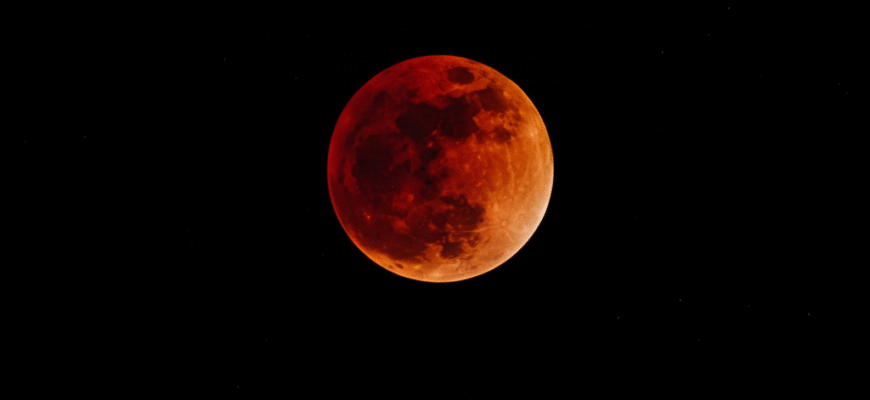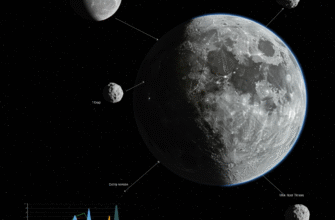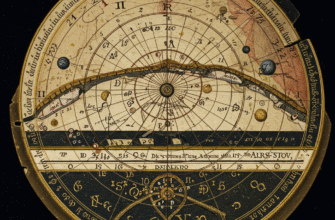The night sky has always been a canvas for human imagination, a vast expanse where we’ve painted our fears, hopes, and grandest stories. Few celestial events stir the soul quite like a lunar eclipse, especially when the Moon takes on an eerie, reddish glow – a phenomenon popularly known as a “Blood Moon.” While science offers a clear explanation for this spectacle, for millennia, cultures across the globe have woven rich and often terrifying narratives around these crimson apparitions.
A lunar eclipse occurs when the Earth positions itself directly between the Sun and the Moon, casting its shadow, the umbra, onto the lunar surface. The “blood” color isn’t sinister in origin; it’s a beautiful trick of light and atmosphere. As sunlight passes through Earth’s atmosphere, a process called Rayleigh scattering filters out most of the blue light, allowing the redder wavelengths to bend and illuminate the Moon.
Scientists explain that during a total lunar eclipse, Earth passes directly between the sun and moon, casting a shadow on the moon. The reddish hue, giving rise to the ‘Blood Moon’ moniker, occurs because some sunlight still reaches the moon, but it first passes through Earth’s atmosphere. This scatters most of the blue light, leaving the red and orange wavelengths to illuminate the lunar surface. This atmospheric filtering is why sunsets and sunrises often appear red as well.
Ancient Echoes: Omens and Cosmic Battles
Long before telescopes and atmospheric physics, the sight of the Moon turning dark and then blood-red was a deeply unsettling event. It was an interruption of the natural order, a sign that something was amiss in the heavens, which often translated to impending doom or displeasure from the gods.
Whispers from Mesopotamia
In ancient Mesopotamia, considered one of the cradles of astronomy, lunar eclipses were meticulously observed and recorded. They weren’t just curious celestial events; they were potent omens, particularly for the king. The Babylonians, skilled sky-watchers, believed a lunar eclipse signaled danger to their ruler. If an eclipse occurred under specific worrying conditions, they would enact a fascinating ritual. A “substitute king,” often a commoner or prisoner, would be appointed to symbolically bear the brunt of the gods’ wrath. This unfortunate individual would enjoy royal privileges for a short period, while the real king hid. If the substitute died during or shortly after the eclipse period, it was seen as the prophecy being fulfilled, and the true king could safely resume his duties.
The Inca and the Attacking Jaguar
Across the Atlantic, in the Andes Mountains, the Inca people had their own dramatic interpretation. They believed that a Blood Moon signified a celestial jaguar attacking Mama Killa, the Moon goddess. Fearful that the jaguar might then turn its attention to Earth, or that the wounded Moon might fall from the sky and bring about the end of the world, the Inca would make a tremendous racket. They shouted, beat drums, and even whipped their dogs to make them howl, hoping the noise would scare away the ravenous jaguar and protect their beloved Moon deity. The reddish color was seen as the blood of the wounded goddess.
Hindu Mythology: The Tale of Rahu and Ketu
In Hindu scriptures, lunar eclipses are tied to the dramatic story of the asura (demon) Svarbhanu, later known as Rahu, and the churning of the cosmic ocean (Samudra Manthan) by gods and demons to obtain Amrita, the nectar of immortality. When the Amrita was produced, the god Vishnu, in the guise of the beautiful Mohini, began distributing it only to the gods. Svarbhanu, disguised as a god, cleverly sat between Surya (the Sun god) and Chandra (the Moon god) and managed to drink a drop. Surya and Chandra, realizing the deception, alerted Mohini, who swiftly decapitated Svarbhanu with her divine discus, the Sudarshana Chakra. However, because the nectar had passed his throat, his head became immortal (Rahu) and his body also lived on (Ketu). Filled with vengeance against Surya and Chandra for revealing his identity, Rahu is said to periodically swallow the Moon or the Sun, causing eclipses. The Moon turning red was seen as it being choked or wounded by Rahu. Rituals, fasting, and chanting are often observed during eclipses to mitigate negative influences.
Northern Wolves and Celestial Dragons
The theme of celestial beings devouring or attacking the luminaries is surprisingly common across cultures, reflecting a primal fear of the dark and the unknown.
Norse Mythology: The Hungry Wolves
In Norse mythology, the constant chase is a central theme. Two powerful wolves, Skoll and Hati Hróðvitnisson, are forever pursuing Sol (the Sun) and Mani (the Moon) through the sky. An eclipse, lunar or solar, was believed to occur when one of the wolves almost caught its prey. The Norse believed that during Ragnarök, the twilight of the gods, these wolves would finally succeed, devouring the Sun and Moon and plunging the world into darkness. A Blood Moon, therefore, could have been seen as a terrifying precursor to this apocalyptic event, a sign that Hati was drawing perilously close to Mani.
Chinese Folklore: The Celestial Dog
Ancient Chinese legends attributed lunar eclipses to a celestial dog, or sometimes a dragon, attempting to eat the Moon. Much like the Incas, the common response was to create a cacophony. People would bang pots, pans, and drums to frighten the creature away and force it to release the Moon. The term for eclipse in Chinese, “shi” (食), also means “to eat,” reflecting this ancient belief. The reddish color might have been interpreted as the Moon being injured in the cosmic beast’s jaws.
The Moon’s Sickness and Need for Healing
Not all interpretations were about attack; some cultures viewed the eclipsed Moon as being sick or distressed, requiring human intervention or compassion.
Native American Traditions
Native American cultures have a rich diversity of beliefs regarding lunar eclipses. The Hupa people of California, for instance, believed the Moon had many wives and pets. When the Moon failed to provide them with enough food, they would attack him, causing an eclipse. The reddish color was his blood. Hupa men would chant and pray for the Moon’s healing. Other traditions saw the eclipse as the Moon being unwell. The Luiseño people of California interpreted a lunar eclipse as the Moon being sick. They would sing chants and prayers aimed at restoring the Moon to health. The Navajo (Diné) have specific traditions and view eclipses as a time for reverence, reflection, and certain abstinences, considering it a sacred period where the cosmic order is interacting.
Many traditional cultures viewed eclipses, especially blood moons, with apprehension. They were often seen as times to stay indoors, perform protective rituals, or avoid looking directly at the event. These beliefs highlight a deep connection with cosmic cycles and a sense of vulnerability to celestial events.
African Folklore: Cosmic Quarrels
The Batammaliba people of Togo and Benin in Africa offer a unique and more reconciliatory interpretation. They see a lunar eclipse as a quarrel between the Sun (male) and Moon (female). During this cosmic dispute, it’s up to the people on Earth to encourage them to resolve their differences. They would enact old feuds and then ritually settle them, symbolically showing the celestial bodies how to make peace. This highlights a belief in humanity’s role in maintaining cosmic harmony.
The “Blood Moon” in Broader Religious and Modern Contexts
The term “Blood Moon” itself, while sounding ancient, gained significant popular traction relatively recently, particularly in some Christian eschatological interpretations. Passages in the Book of Joel (“The sun will be turned to darkness and the moon to blood before the coming of the great and dreadful day of the Lord”) and the Book of Revelation (“…and the whole moon became as blood”) have been linked by some to lunar eclipses, especially series of four consecutive total lunar eclipses known as tetrads.
These interpretations often view Blood Moons as signs or omens related to significant events or prophecies. While these specific interpretations are more modern in their widespread popularization through media, the underlying human tendency to seek meaning in dramatic celestial events is as old as humanity itself. It’s crucial to distinguish between these interpretations as matters of faith and cultural belief, and the astronomical science behind the event.
From Fear to Fascination
Today, with widespread scientific understanding, the primal fear associated with a Blood Moon has largely receded in many parts of the world. Instead, it’s often met with awe and excitement. Amateur astronomers and photographers gather to witness and capture the ruddy glow. Public viewing events are common, turning what was once a terrifying omen into a shared experience of natural beauty.
Yet, a sliver of that ancient unease, or perhaps just profound respect for the cosmos, can still linger. The sight of our familiar Moon, ghostly and red, hanging in the darkened sky, connects us to countless generations who gazed upwards and wondered. The stories they told, of celestial jaguars, hungry wolves, cosmic demons, and quarreling gods, are a testament to the human need to make sense of the universe and our place within it. The Blood Moon, a spectacle of orbital mechanics and atmospheric optics, remains a powerful symbol, a celestial storyteller reminding us of the enduring power of myth and the beauty of the night sky.









